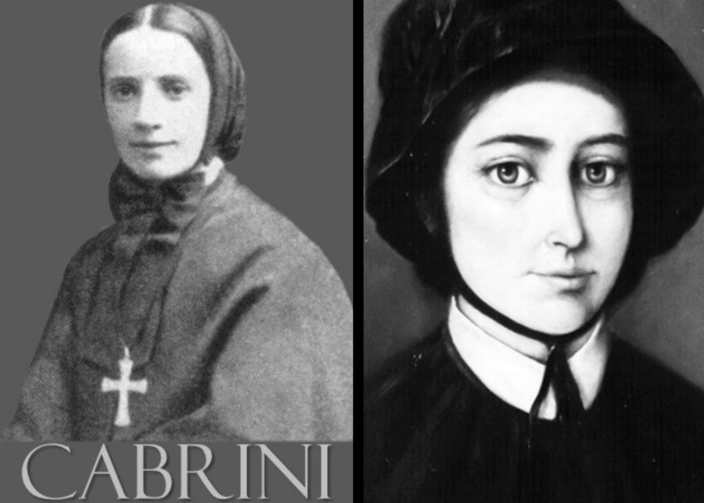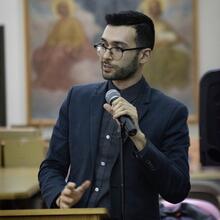Classic films about saints, like “The Song of Bernadette” and “A Man for All Seasons” and more recent releases like Abel Ferrara’s “Padre Pio” and Alejandro Monteverde’s “Cabrini,” take their cues from traditional hagiographies, bringing grandiose renderings of the lives of these holy men and women to the screen. Films like these tend to embellish or fabricate details about the saints’ lives, making them appear “larger than life” to inspire the piety and devotion of the faithful.
“Cabrini,” for instance, produced by Angel Studios (creators of “The Chosen”), follows the traditional model of hagiography, placing Francesca Cabrini’s heroic feats front and center in order to inspire viewers to emulate her laudable example. John Anderson’s glowing review of the film for America described Cabrini, “portrayed by a gauntly radiant Cristiana Dell’Anna,” as one practiced in “speaking truth to power and doing so relentlessly.” The religious sister journeys to New York at the time of "an explosion circa 1887 of Italian immigration, prejudice and poverty [that] was creating a particular kind of hell for their exported countrymen.”
Against immense challenges, Cabrini and her order, the Missionary Sisters of the Sacred Heart of Jesus, go on to found missions, orphanages and hospitals in New York, and, as the film’s coda tells us, around the country and eventually around the world.
(The film has also received some criticisms for overt virtue signaling and downplaying Mother Cabrini’s spirituality.)
Yet new trends among more recent accounts of the saints have been changing the narrative, focusing on oft-ignored and more mundane aspects of their personal lives. Two new films on the lives of Mother Seton and Mother Cabrini, produced by the New Jersey-based couple MaryLou and Jerome Bongiorno and released on PBS over the past week and a half, are placing the spotlight on lesser-emphasized aspects of these holy women’s lives.
Known best for their documentaries on matters of socioeconomic and racial justice and Catholic education in Newark, N.J., the Bongiornos decided to venture into telling the stories of these two women who, they state, have deeply inspired them spiritually and professionally.
Narrated in the first-person and weaving together a creative mix of photos, paintings and cartoon drawings, the documentaries’ scripts draw upon writings by and about the two saints, as well as other historical documents. The films provide a comprehensive view of their lives, including details about their childhoods, their entry into religious life, the founding of their respective missions and the conflicts they confronted, and—perhaps what is most compelling—bits of stream-of-consciousness style, introspective reflections on their work and their relationship with God. The Bongiornos combine their extensive research with their artistic and spiritual creativity in these moments, reflecting the ways that these saints spoke to them and may also speak to us.
As someone who considers himself close to both of these female foundresses, Cabrini and Seton, I discovered much about their inner lives that I never knew from these well-researched and profoundly intimate first-person accounts. The Bongiornos point out that both women came from well-to-do families. They reveal that Mother Seton, despite being aware that material things could not satisfy her craving for happiness, struggled with detaching from her glamorous lifestyle. They cite as examples her excessive concern about her hair and clothing. In addition to this, Mother Seton tended to be a loner with deep-seated social anxiety. At times she sank into depression and suicidal ideations.
Meanwhile, Mother Cabrini was extremely headstrong, rarely taking no for an answer (unless under pain of obedience) or accommodating anything other than her way of doing things. When contemplating her fixation on going on a mission “to the East” rather than “to the West,” as Pope Leo XIII requested of her, she muses on why she allowed herself to “become a barrier to God, and to make other people suffer for it.”
The documentary also demonstrates, in much more painstaking detail than Angel Studios’ rendering of her life in “Cabrini,” the saint’s impressively strategic mindset, business smarts and penchant for networking. And as she herself admits, Cabrini learned “how to work her sense of humor” to charm unwilling donors and sway people (most often men) in power to do things her way.
In the late 19th century, Sigmund Freud’s protégé Josef Breuer diagnosed several female mystics—most notably, St. Teresa of Ávila—of hysteria, attributing their mental instability to their sexual repression. Such strictly materialist takes on the saints’ interior lives chalked up their mystical visions to the stuff of pure delusion, allowing no room for the possibility that they were—at least in part—divinely inspired.
But as of late, I have been coming across more and more psychological engagements with the saints’ interior lives that manage to find room for both material and metaphysical explanations.
Podcasts like Red Scare and meme accounts like @simoneweilfooddiary have taken an interest in how the saints’ stories resonate with neurodiverse identity categories and niche internet communities. People who are on the autism spectrum, or who struggle with eating or personality disorders, so they claim, will likely be able to relate to saints like Teresa, John of the Cross, Joan of Arc or Padre Pio on both a psychological and spiritual level. Memes by other “e-girl” accounts have been known to post paintings of Mary Magdalene with the popular internet phrase “she’s just like me for real!” superimposed over the image in a pink block font.
In recent years, parents, children and siblings of celebrities have published biographies about their more famous family members, often reaching the top of bestseller lists. Think of Life With My Sister Madonna, by Christopher Ciccone; Amy, My Daughter, by Mitch Winehouse; Elvis and Me, by Priscilla Presley; and Remembering Whitney by Cissy Houston. All of these gave readers intimate details about the celebrities’ lives behind the scenes. The sensationalized, tabloid style of celebrity biographies stands in contrast to more measured tellings of the lives of the saints, which aim to incite virtue in the reader rather than gratifying their morbid curiosity and their taste for the salacious.
But I have found that books written by the family members of saints and others being considered for canonization have managed to borrow the contemporary celebrity biography style while having the effect of traditional hagiographies. Books like Beauty Will Save the World, by Servant of God Dorothy Day’s granddaughter, Kate Hennessy, and My Son Carlo, by Blessed Carlo Acutis’ mother, Antonia Salzano Acutis, have given me a detailed view of these holy people’s extraordinary dedication to God and neighbor.
They also provide me insight as well as into their personality traits, quirks, moral struggles and even their taste in art and food. Such details tend to get glossed over in traditional hagiographies written by those less close to the holy person.
Hennessy, for example, recounts her grandmother’s quickness to judge others and her short temper, which was directed especially harshly toward her own daughter, Tamar. Hennessy remembers watching Dorothy hanging up the phone after having scolded Tamar. Hennessy remarked to Day that she ought to learn to control her temper better. Then Day took off to her room to pray for forgiveness and the grace of greater patience.
Hennessy also remembers how Dorothy savored listening to Russian classical music in the evenings and how she relished baking cornbread in the mornings, describing her facial expression as prayerful when engaging in such beloved activities.
Similarly, Antonia Salzano Acutis depicts that for her son, Carlo, adoring Christ in the Eucharist, engaging in discussions with the homeless, going hiking in the mountains and playing with his dogs were all means for him to give glory to God. His deep piety was not separate from but rather informed his more quotidian affairs: from playing computer games to sneaking into the kitchen to grab a dessert to satisfy his sweet tooth.
As you dig into the book, it is not hard to tell that Carlo was an avid techie, a “nerd” by some standards. Yet his passion for all things tech-related became a tool in his journey along the “highway to heaven.”
Such details serve to humanize these figures and have taught me how to offer my greatest weaknesses as well as my seemingly inconsequential interests and personality traits to God with greater gusto.
As the narrator in the Bongiornos’ rendering of Mother Cabrini’s life claims, uncritical tellings of the lives of the saints risk making “the saints look like perfect people.” But to the Bongiornos, including the less impressive or glamorous details about a saint’s life makes their story more compelling, proving to us that we all “can get there” and that when we struggle, it becomes easier to “ask [them] for some help,” knowing that they went through struggles similar to ours.
Such accounts of the lives of the saints remind me that even people like me—people who struggle with emotional instability, who sometimes have a nasty attitude, like certain forms of music more than others, and even those who have a weakness for pastries—can become saints. We often forget that the measure of sanctity does not lie in our capacity for perfection or moral coherence. Rather it resides in the sincerity with which we offer our full selves—including our strengths and weaknesses, our likes and dislikes—to God for him to use for his glory.








